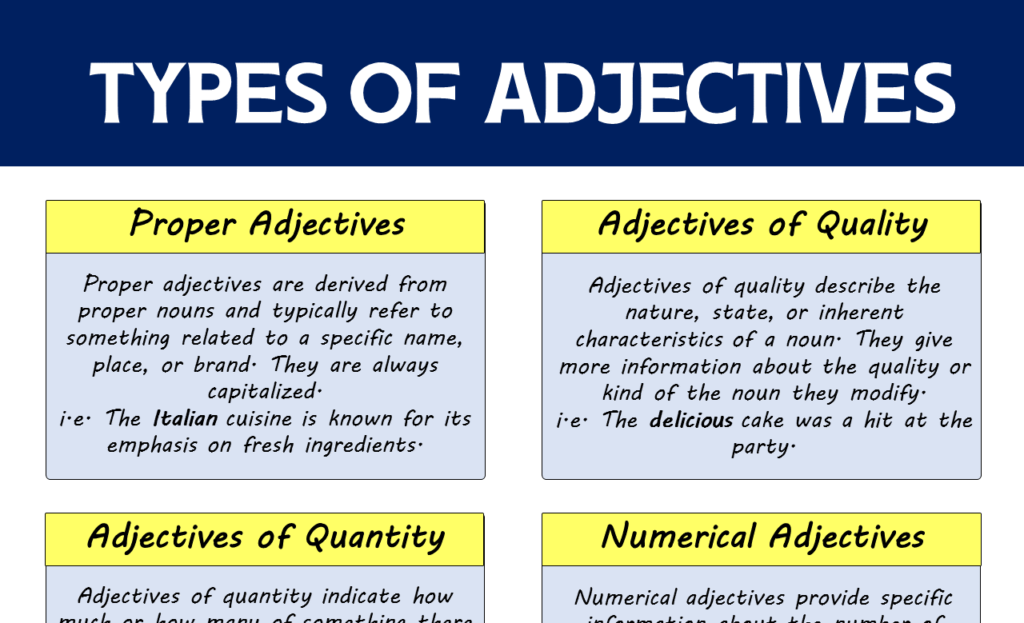Compound adjectives are invaluable tools in English, allowing writers to succinctly convey detailed descriptions and nuanced concepts. A compound adjective is formed when two or more words are combined to modify a noun, often enhancing the clarity and specificity of a description. This blog post will explore what compound adjectives are, why they’re important, and how to use them effectively in your writing.
What Are Compound Adjectives?
A compound adjective occurs when two or more words are joined together to modify a noun and describe its attributes more precisely. These words are often linked with a hyphen to avoid confusion or ambiguity. For example, in the phrase “well-known author,” “well-known” is a compound adjective that gives us more specific information about the noun “author.”
Why Use Compound Adjectives?
Compound adjectives can make your writing more concise and impactful. They allow you to pack more descriptive power into fewer words, making your sentences cleaner and more compelling. Additionally, they can help to clear up potential misunderstandings by tightly linking words that are meant to be read and understood together.
How to Use Compound Adjectives?
Using compound adjectives correctly involves recognizing when words need to be hyphenated to function as a single descriptor before a noun. Here are some tips and common types of compound adjectives:
1. Adjective + Noun
When an adjective pairs with a noun to modify another noun, they are often hyphenated to clarify that they function together as a single descriptor.
- Full-time job
- High-speed internet
- Long-term goals
- Short-term memory
- Open-air market
2. Noun + Adjective
This type of compound adjective occurs when a noun and an adjective combine to describe another noun, emphasizing certain qualities or features.
- Ice-cold water
- Steel-gray eyes
- Honey-sweet voice
- Snow-white beard
- World-famous chef
3. Noun + Past Participle
A noun combined with a past participle can form a descriptive compound adjective, often relating to the state or condition resulting from an action.
- Sun-dried tomatoes
- Wind-swept plains
- Hand-painted mural
- Oil-soaked rag
- Wax-coated paper
4. Adverb (not ending in -ly) + Past Participle
When an adverb that does not end in -ly combines with a past participle, they are usually hyphenated to form a clear modifier.
- Well-known author
- Hard-won victory
- Long-lost friend
- Ill-fated voyage
- Much-needed rest
5. Adverb (not ending in -ly) + Adjective
Similarly, when an adverb not ending in -ly combines with an adjective, it forms a compound adjective that modifies nouns for clarity and emphasis.
- Best-selling book
- Fast-growing company
- Hard-earned money
- Never-ending story
- Well-deserved break
6. Number + Noun
This form of compound adjective is very common and occurs when a number and a noun combine to describe another noun, usually indicating quantity or duration.
- Two-hour delay
- Five-star hotel
- Ten-year anniversary
- Three-week vacation
- Six-page document
7. Adjective + Past Participle
This type of compound adjective involves an adjective combined with a past participle, often describing the result of an action or a state.
- Broken-hearted lover
- Open-minded approach
- Well-prepared report
- Ill-fated relationship
- Freshly-baked bread
8. Adjective + Present Participle
Combining an adjective with a present participle can modify nouns to describe ongoing actions or qualities.
- Long-lasting effect
- Far-reaching consequences
- High-paying job
- Low-yielding investment
- Strong-smelling cheese
9. Color + Noun
Compound adjectives that start with a color can vividly describe objects, especially when the color word helps to specify a particular quality or characteristic.
- Sky-blue eyes
- Blood-red sky
- Snow-white sheets
- Pitch-black night
- Rose-pink lips
10. Gerund + Noun
When a gerund (a verb form ending in -ing that functions as a noun) teams up with a noun to modify another noun, it often describes the purpose or functionality.
- Swimming-pool maintenance
- Racing-car driver
- Walking-stick insect
- Sleeping-bag liner
- Reading-lamp bulb
11. Number + Adjective
Numerical values combined with adjectives can describe specific features or rankings, adding a quantitative element to the description.
- One-way street
- Six-figure salary
- Third-rate hotel
- First-class seat
- Two-dimensional image
12. Proper Noun + Noun
Sometimes, a proper noun combined with a common noun forms a compound adjective, which often indicates origin or association.
- Victorian-era architecture
- Shakespearean-style drama
- French-style cuisine
- Edison-inspired invention
- Darwinian-evolution theory
13. Action Noun + Past Participle
This type involves nouns that imply an action, combined with a past participle, describing something that has been subjected to the action.
- Wind-blown hair
- Storm-tossed ship
- Sun-bleached fabric
- Water-damaged documents
- Fire-ravaged forest



